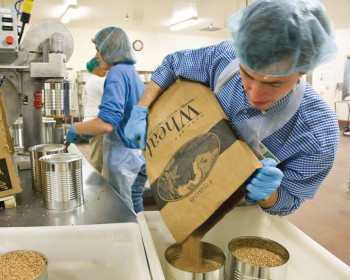The second purpose is to provide food for those who are in need. Much of the food canned or created goes to what are known as Bishop’s Storehouses. These look like small grocery stores except they don’t have cash registers. Church members who are in need meet with their bishops to evaluate their budgets and learn how to live on less. They can also receive permission to fill out a food order. From a list of available items, they mark what they need and in what quantities. The bishop can make adjustments (up or down) and then they take the list to the storehouse, where someone helps them fill the order.
However, the canneries are also used to help local charities feed people. The Salvation Army, Utah Food Bank Services, Jewish Family Services, Houston Food Bank, and Metro CareRing are among the many non-Mormon organizations that make use of the canneries. Some provide their own food items while the church provides them with cans, lids, labels with the name of the charity, not the Mormon Church, and free use of the cannery. Other organizations provide only volunteers to do the work.
The Denver cannery devotes three months a year to outside charities, with the remaining time devoted to serving their own people. The project in Denver began twenty years ago. At that time, the cannery arranged for local farmers to donate surplus crops to be canned for those in need. The current program provides peanut butter to the Houston Food Bank. The food bank provides the peanuts and the Mormons provide everything else. The food bank is able to produce a jar of peanut butter for only 91 cents this way and is able to provide 95,000 jars of peanut butter a year to those who come to them for help. Peanut butter is very popular with food banks because it’s nutritious and doesn’t require refrigeration, additional ingredients, or even dishes to be enjoyed. It’s also popular with children. Having a large quantity of one item consistently available and prepared in advance provides them with some security and the ability to better plan.
The Mormons provide services to the poor, both LDS and non-LDS, in a variety of ways. The storehouses food, mentioned earlier, is paid for through a unique program called Fast Offerings. Once a month, Mormons are asked to not eat or drink anything—not even water—for twenty-four hours if they are physically able to do so. This actually only requires them to skip two meals, plus snacks. They donate the money they saved by not eating to their congregation, which then uses the money to take care of the poor. In that way, Mormon congregations, who consider themselves a family, take care of their own. It takes nothing extra out of their budget, but does require some sacrifice on each person’s part. The receivers “pay” for what they receive by accepting church assignments, including working at the storehouse for a few hours. The work seldom equals what was received, but it allows the family to maintain their self-respect, knowing the help was not a handout. They also know they’ve helped others in the past, and will again in the future, and all of this makes it easier to accept help in the proper spirit.
Another way . This program serves the poor world-wide, and is not specifically for Mormons. Volunteers might use these funds to provide clean water for a village, help native people build a school yard, provide wheelchairs for those who can’t afford them, or provide training to villagers in caring for premature infants. Normally, the people who receive the gifts are expected to participate, offering some of the labor and providing people to train in maintaining whatever is provided.
These are just a few of the many programs offered by the Mormons, through a variety of programs, to assist those who need a temporary hand to get their lives back on track.
To learn about the cannery programs to assist hunger groups, see:

